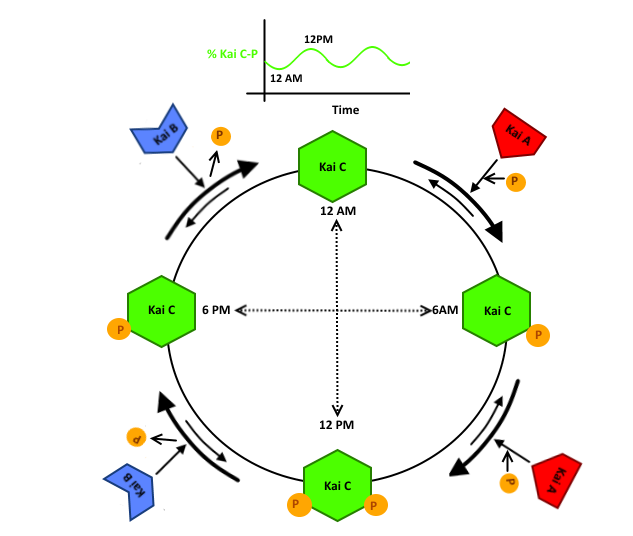Team:UChicago/Description
Yay, we can’t believe
you fell for the clickbait. Here’s a picture of a cute cat:

Anyways, onto our project:
Background

Figure 2: Schematic of
how KaiB and KaiA stimulate
different phosphorylation states of KaiC in a
circadian rhythm. CATS.
Circadian rhythms are found in a diverse range of species, using a series of oscillatory proteins to govern everything from sleep in humans to cell cycle progression in fungi. The well characterized Kai ABC circadian oscillator in cyanobacteria has been demonstrated to regulate photosynthesis, cell division, nitrogen fixation, and a host of other essential cell processes. Because of this wide range of downstream functionality, the ability to reconstitute this robust oscillator would allow us to control the production of a target molecule on a 24 hour time scale, such as caffeine or melatonin.
The Kai ABC system is composed of three proteins, Kai A, Kai B, and Kai C. Kai A acts to autophosphorylate Kai C at one of 2 sites, either T431 (T) or S432 (S). Kai B then acts to auto-dephosphorylate Kai C. Previous research (cite that one paper)has shown that Kai B and Kai C are present in equal stoichiometries, and that the oscillatory character of the system is due to a change in Kai A concentration.
The 2015 iGem team has 3 main goals:
1) The first is to reconstitute the Kai ABC oscillator in E. Coli. The oscillator is native to cyanobacteria, and reconstituting it in the most widely used model organism in biomedical research serves as a proof of concept for further applications of the oscillatory system.
2) 3) The second goal is to develop a readout system to allow us to assay the downstream effect of the system at various time points during its oscillation by investigating the proteins RpaA, SasA, and CikA. RpaA, SasA, and CikA are components of an expression system directly downstream of KaiABC. RpaA is a master transcription factor that connects the circadian pattern occurring on the protein-protein level in KaiABC to gene expression. SasA and CikA act in similar manner to KaiA and KaiB, phoshporylating and dephosphorylating their substrate RpaA respectively. SasA and CikA directly bind and interact with the KaiABC proteins as well as act on RpaA. While previous studies of transplanting the KaiABC system have demonstrated the ability of SasA and KaiC-P interaction to drive expression, we hope to show oscillations of the RpaA master regulator itself. With the inclusion of the negative regulator CikA, we hope to generate oscillations of RpaA and a downstream kaibc promoter which were not reported in previous studies.
The third goal is to link the oscillation to the expression and secretion of AANAT (and if ben could explain more here that would also be great, cause I really have no idea what’s happening with this part )[KY1]
Next, want to ****** the ***** of your ****? Click here!
[KY1]This would be not good to include in the final wiki lol
Like our team Facebook page, Genehackers@UChicago!
Questions? Comments? Send us an email!
